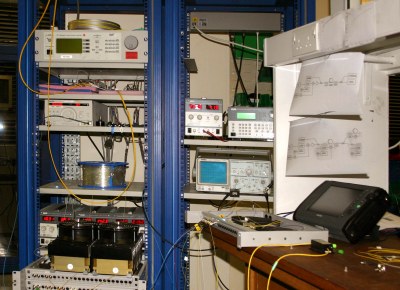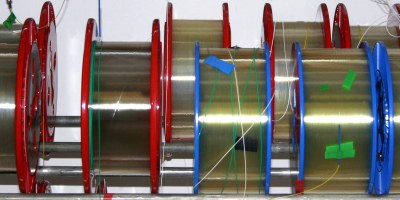A 75 kilometre long optical fibre that can carry a pulse of laser light without loss of power could revolutionise long-distance voice and data transmissions, according to UK researchers. The team says the fibre could span the distance between Edinburgh and Glasgow without requiring signal boosters en route.
Juan Diego Ania-Castañón and co-workers Tim Ellingham, Robin Ibbotson, Xianfeng Chen, Lin Zhang, and Sergei Turitsyn at Aston University were well aware that energy loss is the bane of optical communications networks. Data transmitted as a light signal through optical fibres lose about five percent of their power for every kilometre of fibre optic. To span long distances signal boosters, which add expense and have to be maintained, are added at regular intervals to prevent total deterioration. One approach exploits the Raman effect to pump up the laser signal at the end of a segment of fibre and so amplify the signal. However, Raman amplification is not uniform through the fibre’s length, so if you want to use a lot of different wavelength signal channels then multiple pumps are needed to prevent signal power from varying during propagation.

Sergei Turitsyn, Juan Diego Ania-Castanon, Lin Zhang, Xianfeng Chen and Robin Ibbotson
Despite advances in signal-boosting technology and other improvements the simplest solution to data loss would be to improve the efficiency of the fibre optics themselves. Now, Ania-Castañón and colleagues have devised an alternative scheme for exploiting the Raman effect. Their technique almost eradicates variations in signal power along the length of the fibre, effectively extending the distance across which data might be transmitted without the need for so many laser pumps.
The approach is based on placing a mirror, or more specifically a Bragg grating, at each end of the fibre that reflects light of only a single wavelength, 1455 nanometres in fact. This is light of much lower energy than the pump laser wavelength but higher energy than the signal being transmitted. As such, the pump laser light passes through the mirrors, enters the fibre, and induces the Raman effect at 1455 nm. These photons bounce back and forth along the length of the fibre between the mirrors and stimulate the Raman more having the effect of pumping up the whole length of the fibre at this wavelength, and amplifying the signal uniformly.

Workbench
In the field of telecoms, the use of quasi-lossless transmission links such as ours leads to a direct reduction of the noise, Ania-Castañón told Spotlight, This noise reduction can be used to either increase the potential transmission distance of a given communication system, or to increase the system’s capacity (data rate), or even both simultaneously.

Optical fibre
Further reading
Phys. Rev. Lett. 96, 023902
http://link.aps.org/abstract/PRL/v96/e023902
Dr Juan D Ania-Castañón
http://www.ee.aston.ac.uk/contacts/aniacajd.html
Suggested searches
optical fibres
fibre optics
Raman effect